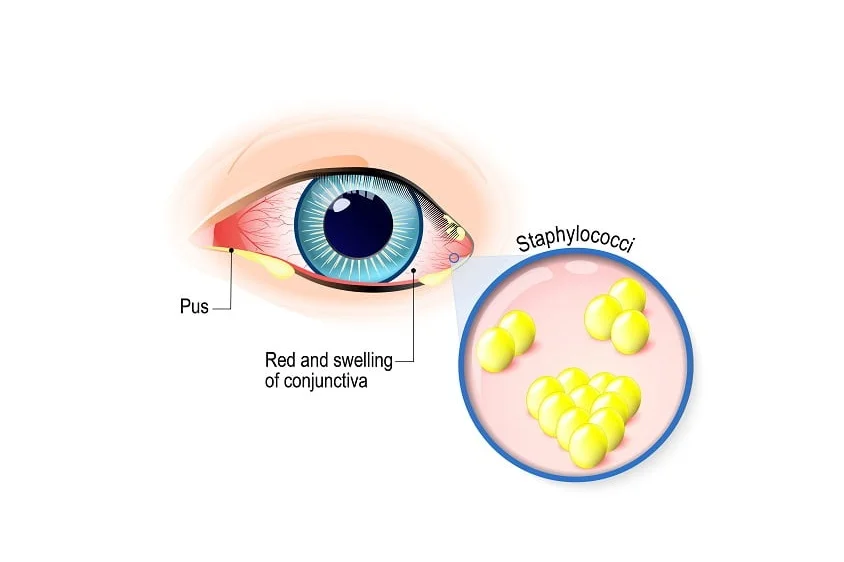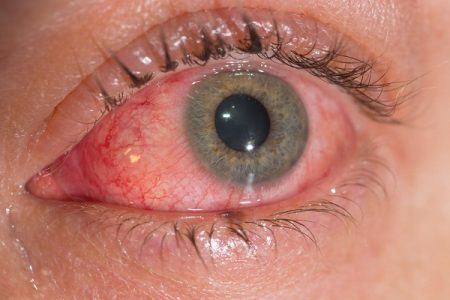What Are the Causes and Risk Factors of Conjunctivitis?
- Updated on: Jul 9, 2024
- 3 min Read
- Published on Oct 2, 2019

Causes of Conjunctivitis
Conjunctivitis is a highly contagious infection and can widely spread in the environment. There are many causes of conjunctivitis like bacteria, viruses, chemicals, use of contact lenses for a long time, Chlamydia, parasite, etc.
Types of conjunctivitis
On the basis of causes, conjunctivitis is divided into following types:
Bacterial conjunctivitis

Bacterial conjunctivitis is the most common type of pink eye infection. It is caused by bacteria that can infect eyes through any external source. The bacteria can spread through various means such as close contact of eyes with any contaminated surface, pollutants in the air, or any external infection source like ear infection, sinus, etc.
In bacterial conjunctivitis, a thick, yellow colored, sticky eye pus or discharge is produced that can infect one or both eyes.
Some of the most common bacteria causing bacterial conjunctivitis are-
- Staphylococcus aureus,
- Haemophilus influenza,
- Pseudomonas aeruginosa,
- Streptococcus pneumoniae
Bacterial conjunctivitis is usually treated by antibiotics, eye drops or eye ointments. Its treatment takes around 2 weeks based on severity.
Viral conjunctivitis
In viral conjunctivitis, the eyes produce a watery discharge. Since viruses can spread very quickly through air while sneezing and coughing, the viral conjunctivitis is highly contagious. It generally starts in one eye but soon infects the second eye also.
Viral conjunctivitis cannot be treated with antibiotics, eye drops or any ointments. It is a self limited infection and goes away itself after a short period of time. Usually the fourth and the fifth day of infection are the worst. After that, the eye condition starts improving itself. Doctors can, though, prescribe some supportive medications in the form of eye drops in order to control the symptoms.
Chlamydial conjunctivitis
Chlamydia trachomatis is the organism that causes chlamydial conjunctivitis. This organism can infect other body parts and may cause sexually transmitted disease called Chlamydia.
In chlamydial conjunctivitis, the eyes become red with swollen eyelids and secrete a sticky discharge. It is generally treated with antibiotics to eliminate the infections.
Neonatal conjunctivitis
Neonatal conjunctivitis is a type of pink eye infection that is mostly seen in newborns. In such cases, if the infection is left untreated, it may lead to blindness in newborn babies.
Neonatal conjunctivitis is caused during the pregnancy of a woman who is suffering from sexually transmitted disease. If such infections are left untreated, it can lead to severe form of conjunctivitis resulting in blurred vision in the newborns.
Allergic conjunctivitis
Allergic conjunctivitis is the type of pink eye infection that is caused by certain eye infections. It is one of the most common types of eye infection found in the people. There are many factors that trigger the occurrence of the infection. Some of them are:
- dust mites
- pollen grains
- animal dander, etc
An itchy eye is the most common symptom of allergic conjunctivitis. Doctors generally prescribe eye drops containing antihistamines that can help to control eye allergy.
Giant papillary conjunctivitis
Giant papillary conjunctivitis (GPC) is a type of pink eye infection that usually occurs in both eyes. It generally occurs in those people who wear soft contact lenses. This condition can cause contact lens intolerance, itchiness, sticky and heavy discharge, tearing and red bumps in the inner side of the eyelids.
Doctors recommend not wear contact lenses for a long time to avoid giant papillary conjunctivitis.
Chemical Conjunctivitis
Chemical conjunctivitis is another type of infection which is caused due to pollutants and other chemical compounds that are present in the air.
The causes listed above are some of the most important reasons behind the pink eye infection and may lead to severe complications if left untreated.
It is very important not to neglect the symptoms and consult your doctor in order to get the most appropriate treatment.
Risk factors that trigger conjunctivitis
Although there are many causes of the pink eye infection, there are certain factors that trigger the initiation of the infection. Such risk factors may even worsen the infections.
Following are some of the most common risk factors associated with conjunctivitis.
- The infection is more prevalent in children and elder people as compared to adults. This is because of the fact that children come in contact of many germs and microbes and elder people have weak immunity against infections.
- If a person is suffering from respiratory infections such as cold , etc., there are high chances of developing conjunctivitis
- If the immune system of a person becomes weak due to some other disease such as diabetes, etc, he or she might get conjunctivitis very easily
- A person is at high risk of having conjunctivitis if he is taking corticosteroids as such medicines tend to weaken the immune system
- A person may also get conjunctivitis if he or she suffers from blepharitis, an inflammation of eyelids
- A person exposed to chemicals may also suffer from pink eye infection











